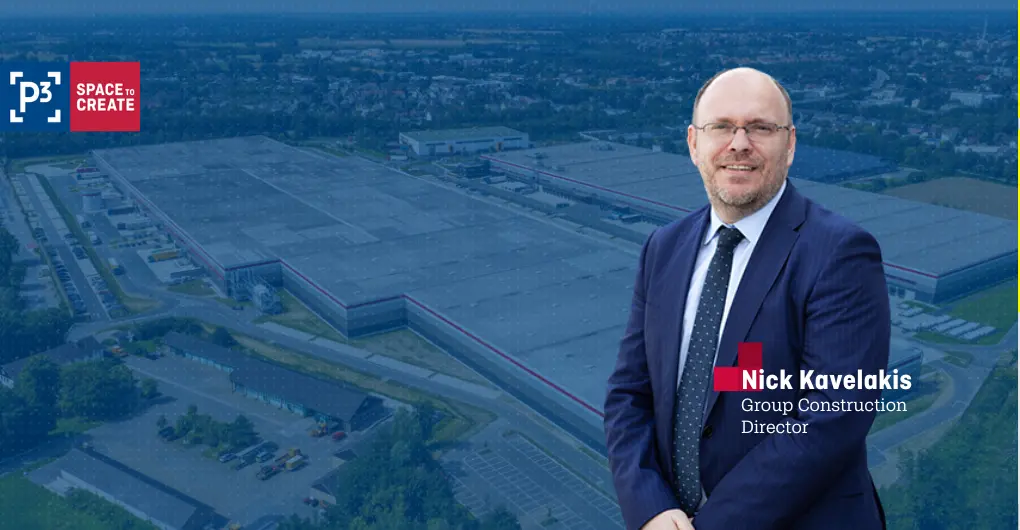

Prices of energy and materials have soared during 2022 in sectors across Europe, including construction. Costs are forecast to stay high or keep rising in the short to medium-term, posing challenges for developers and suppliers. During this disruption, P3 is committed to fully serving customers, says Nick Kavelakis, Group Construction Director at P3. He sets out how surging inflation and energy prices affect warehouse developers.
What’s going on?
“The critical issue is the rising cost of oil, electricity and gas, with the related but distinct challenges of rising inflation and stagnating global economic growth. Energy is influential in how materials reach construction sites, in terms of manufacture and transportation. Right now, many production lines cannot make things economically due to rising prices, or are still not fully recovered from the effects of the pandemic, so they don’t produce as much as they can - and want - to deliver.
“We see inflation skyrocketing in most European countries to unprecedented record highs. P3 can find the materials, but their cost has increased significantly; we’ve seen some spikes of over 100% in some cases, over the past three months. Normally, you expect inflation-level rises annually, or for prices to float just above inflation. These price increases significantly impact the production of materials like steel and concrete, for example, which we need in abundance for what we do.
“There’s also the legacy of supply chain disruption from the pandemic, which affects the production, transportation and delivery of materials. The Ukraine conflict is adding extra disruption to an already disrupted situation; it’s like a ‘double whammy’ for the markets. This is an unprecedented situation in many ways that affects almost every business, not just construction.”
How does this affect the development of warehouses?
“Construction costs have calibrated upward due to the conflict in Ukraine, continuing a trajectory started by the global health crisis. This combination of factors means the construction industry is dealing with a far more complicated puzzle than we have ever seen.
“Fast-rising prices for materials is a new topic we’re busy with, and it changes on a daily basis. For example, we have witnessed significant tender inflation in our supply chain during the past three months of well above 20% in some instances. Contractors make us offers for Works that used to be valid for 45-90 days, but nowadays these are valid for two weeks or less, as they struggle to track where prices are headed. Furthermore, we find some of the contractors we’ve traditionally worked with, will now only commit to longer delivery times for these Works, as they are concerned about the ability of their supply chain to deliver materials, equipment, systems to sites, on time.
“We are also getting to grips with understanding what the risk magnitude is, as the pricing of it has evolved to new levels. This disruption makes forecasting additionally challenging and adds to the uncertainty. So, we’re doing more forecasting to model what will happen, especially to commodity prices. We keep our eyes and ears close to the ground and are in constant contact with contractors in our supply chain.”
What is P3 doing for customers during this challenging period?
“Our number one priority is our customers, and this focus motivates us to deliver for them. This is why P3 has not stopped a single project and we continue to deliver assets on time, according to the agreed terms; including commitments made long before the conflict in Ukraine began. This focus upon our customers is non-negotiable, no matter what the pressures are from the external environment.
“One of the benefits which P3 offers is our financial strength and stability, thanks to our shareholder GIC, the sovereign wealth fund that manages Singapore’s foreign reserves. This means we can give customers confidence in ways some developers cannot, as we’re a long-term owner, investor, developer and asset manager, not an opportunistic, short term player. We’re also focusing hard on managing the construction process, in terms of making sure projects complete on time and meet our deadlines. This has traditionally been one of our strengths and remains one.
“It’s worth noting we have not seen demand for industrial real estate decreasing or slowing down in the majority of markets we operate in. There is still an appetite among clients to develop further and that’s why we’re in business, to deliver for them.”